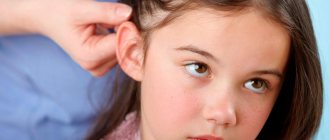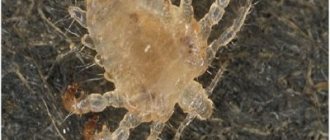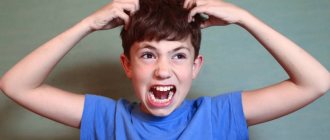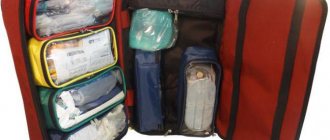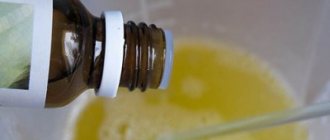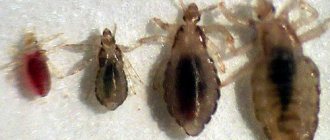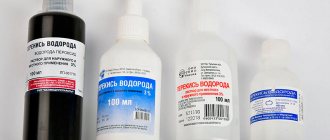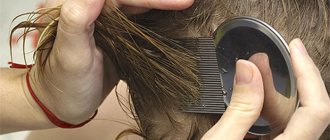How to treat pediculosis
Previously, in most cases of lice infection, people had to shave their heads, but now there are many ways and means to rid hair of lice and nits. Treatment can be carried out independently at home, or you can contact a specialist to prescribe medications.
This method is very effective and ideal for self-treatment, since almost every person has a hair dryer or hair straightening iron at home. Because lice die at temperatures above 50 degrees Celsius, thorough hair drying or straightening can kill them.
Pharmacies sell a large number of products aimed at combating lice and nits. They are produced in the form of balms, sprays, shampoos, creams, solutions, gels and ointments. These products contain components that destroy the nervous structure of insects. But their effectiveness is not 100%, since they act directly on lice, and not on nits.
Products that contain dimethicone and cyclomethicone act on a different principle; they envelop both lice and nits with a thin, durable film that does not allow air to pass through, as a result of which the insects die. These drugs are highly effective, but can cause allergies.
Before purchasing any medicine, it is recommended to consult a doctor, especially if children under 6 years of age and/or pregnant women are being treated.
People know dozens of ways to combat annoying parasites, including:
- petrol;
- kerosene;
- dichlorvos;
- vinegar;
- hydrogen peroxide;
- laundry soap;
- decoctions of poisonous plants;
- and much more.
In the modern world, pediculosis is not considered a disease of “dirty” and “sloppy” people, since absolutely anyone can become infected with it. Treatment should begin immediately as soon as nits are discovered in the hair, since it is not difficult to remove them when there are few of them, but after 1-2 months a horde of insects will cause a lot of suffering to its owner.
How to destroy nits and lice during the incubation period
First of all, carefully examine the head, paying attention to the roots of the hair. That's where the nits are. They are very small - only 1 mm long. But there can be a lot of them, and in large quantities they look like dandruff. It is worth considering that with the naked eye it is impossible to distinguish nits with larvae developing in them from empty ones. This is visible only at high magnification (more details in the article “How to detect lice and nits”).
If less than five days have passed since contact with a lice carrier or with his personal belongings, it is necessary to get rid of nits. They are attached to the hair using a very sticky substance. To peel them off, you need to use special tools. Among the traditional methods, acidic substances help well - a vinegar solution, for example. You also need a comb with very fine teeth to thoroughly comb out nits and lice (for more details, see the article “How to get rid of lice”).
In any case - when the lice are still developing or have already hatched - they need to be dealt with. For this, we recommend a line of professional pediculicides produced by the Moscow company Laboratory Medilis. These drugs are: Medilis - Permifen, Medilis-Malathion, Medilis-Super, Medilis-I, and Medilis-BIO lotion is intended for the treatment not only of adults, but also of the youngest patients from 5 years of age.
What determines the length of the incubation period for pediculosis?
Summarizing, we can sum up how long it may take for a person infected with lice to fully feel the presence of parasites on his body and sound the alarm. Its duration is affected by the type of lice, their initial number that got to the victim, as well as the circumstances that provoked the infection. It is the last point that has not yet been disclosed, although the protective measures that can be taken to avoid such a nuisance as encountering lice directly depend on it.
Most often, such situations lead to the discovery of blood-sucking insects.
- Long-term isolated accumulation of people - work collectives, organized recreation (boarding houses, tourist centers, camps, sanatoriums, hotels, collective hikes), places of deprivation of liberty, dormitories, boarding schools, barracks, camps for refugees or victims of disasters.
- Organization of studies and leisure (school, kindergartens, nurseries, clubs, sports sections, fitness, gym, swimming pool).
- Traveling on a train, especially with an overnight stay, or on a plane or bus over a long distance.
- Visiting hairdressing salons, public steam rooms and saunas.
- Renting temporary housing, be it a hotel or a rented apartment.
It is no less dangerous to try on or borrow other people's things - linen, towels, clothes, hats and headwear.
How lice get on the human body
These parasites cannot fly or jump, so they can only crawl very quickly. They have powerful, tenacious legs, so they can easily move along horizontal and vertical surfaces. However, outside the human body and food, lice live up to a day, so most often their transmission occurs through direct contact. In addition, you can become infected with pediculosis through
- • comb;
- • towel or bed linen;
- • hats.
Insects remain viable in water for some time, so in open water there is a low risk of them getting on the body
Timing depending on treatment method
If the presence of lice is confirmed, you need to prepare for a long and grueling fight against this parasite.
Mechanical method
This method of combating lice and nits can be considered effective, but time-consuming and labor-intensive. It includes daily combing out parasites with a thick comb with a distance between teeth of 0.2 mm, and inspecting the hair. After each combing, the comb must be thermally treated.
The second method of eliminating lice is shaving the hair bald. Of course, it may not be suitable for everyone, except perhaps for children and adult men. It would be a pity if the girl has gorgeous long hair. Here parents will have to work hard in the fight against insects.
High temperatures
Lice are afraid not only of cold, but also of exposure to high temperatures. In some cases, lice may become lethargic and not as active at a constant temperature of +200C. The higher the temperature rises, the worse the parasite becomes. From excessive heat it moves away from the skin.
- If the temperature is above +400C, then the lousy female cannot reproduce.
- When the temperature ranges between +45-600C, adult individuals may die. But the larvae are more resistant to such heat.
- If the indicator exceeds +600C and above, then rotten eggs die at this stage.
When exposed to high temperatures, lice's internal organs are disrupted, which leads to their death. You can use hot air from a hair dryer, an iron, or a trip to the bathhouse.
Chemicals
In pharmacy chains you can purchase special drugs - pediculicides. By treating your hair with it, you can get rid of parasitic insects. Please note that such products cannot always produce results after one application; most often, repeated treatment is required. After treatment, re-washing the hair is carried out no earlier than three days later.
Depending on the age category of the patient, a chemical substance is selected. This category of drugs is not suitable for combating lice in children, pregnant and nursing mothers. This could be Pedilin, Pedex, Parasidosis and others.
The same medication should not be used more than three times. Carry out the treatment with rubber gloves.
Folk remedies
The mechanical method uses a special comb with fine teeth. Neem's hair is combed daily to remove nits and adult parasites. Combing must also be done after baiting lice for several days.
Since ancient times, lice have been fought with the help of dust soap, which can negatively affect insects at any stage of their development. The hair is washed, a film cap is put on top for 10-15 minutes, then the head is rinsed with water. Treatment should be carried out several times for preventive purposes.
Another effective folk remedy is kerosene.
It must be handled with care as it is a toxic substance. The same goes for hellebore water.
It is not used for children.
Types of lice and reproduction characteristics
There are 3 types of lice:
- Head ones are the most common variety. They parasitize the scalp.
- Pubic - settle on hairy areas in the groin area, in the armpits, less often on the eyelashes and eyebrows. These lice do not live on the head, because due to the structure of their paws, they cannot hold on to and move through hair with a round cross-section.
- Body lice are a subspecies of head lice that live on clothing and in the folds of linen. Parasites move onto the human body only to feed on blood.
An interesting feature of lice reproduction is that a female, after mating once, can subsequently reproduce without the participation of a male. She lays eggs for 2-3 weeks. This is explained by the fact that during the mating process, all eggs are fertilized by seminal fluid at once.
Varieties
The reproduction period of lice takes from 12 to 20 days. During this time, the insect goes through an incomplete cycle of transformation from an egg to a mature individual, bypassing the pupation stage. The reproduction process of different types of lice is almost identical, since the existing differences are insignificant.
What conditions are required for reproduction?
Temperature values from +22⁰С to +44⁰С can be considered normal for the life and reproduction of lice. At lower temperatures, life processes are inhibited; at higher temperatures, insects die. The timing of the appearance of a new generation of parasites also depends on the thermometer readings. The closer the temperature is to optimal values, the faster the development process occurs.
In order for mating to occur, both adults must be well-fed. The presence of a constant source of food is another condition for the reproduction of lice on the head or pubic area of a person, since the female makes another clutch only after drinking blood.
Reproduction rate
Lice on the head multiply quickly, since fresh blood is always available, and for the reproduction process, as stated above, the female only needs one mating with a male. Adult lice lay eggs after each meal, which occurs between 3 and 5 per day, and do so for the rest of their lives.
Body lice reproduce the fastest, followed by head lice in terms of reproduction speed, and pubic lice reproduce the slowest.
How many eggs do they lay?
The rate at which lice reproduce depends on temperature and the availability of fresh blood. The number of eggs that a louse lays during the day and throughout its life varies quite greatly among representatives of different species.
The body louse lives longer than others, and lays 7 - 10 eggs per day. Thus, a female can lay up to 300 eggs over her entire life. Head lice have more modest numbers - from 120 to 150 eggs. And finally, the number of eggs that a pubic louse lays during its life is from 40 to 80.
Incubation period, time frame and how long does it take for lice to emerge from nits?
How long does it take for lice to emerge from nits? The incubation period of nits in humans takes longer than the development period of adults and is approximately 7 days. Nits are eggs (you will learn how long it takes for lice eggs to hatch) that are laid by lice. They look like small grains of light, almost white color.
At one time, an adult creature can lay 4-5 parasites. Lice attach cocoons closer to the hair roots using an adhesive composition. This fact makes treatment difficult, because it is extremely difficult to select all the nits. Read more about treating nits with vinegar at home in our article. And if you have long hair, use our combing instructions.
How many days does it take for a nit to mature? The incubation period of the parasite from egg to adult organism is from 16 to 30 days. The speed of development and when nits hatch, as mentioned above, is affected by temperature. From birth to the end of life, lice go through 4 stages of development:
- egg;
- larva;
- nymph of the first and second order;
- mature individual.
Stages of development from larva to adult:
- mature larvae develop in one day and turn into a first-order nymph at an ambient temperature of 30 degrees. The lower the air temperature, the longer the incubation period of the offspring will last. For example, at 10 degrees the transformation can last up to 10 days. Nymphs of the first order are similar to full-fledged adult representatives, differing only in their small size, as well as the underdevelopment of the genital organs;
- nymphs of the first order undergo molting in 5 days and turn into representatives of the second order;
- The second-order nymph matures in 8 days. At this stage, the louse turns into an adult organism capable of fertilization (adult stage).
On our website you can learn more about the types of lice and how to get rid of their eggs. Lice multiply rapidly. How many days does it take for lice to emerge from nits? A month after the first individual enters, the colony of lice will be numerous, which will bring a lot of discomfort to the infected person. Mating of a newly-made individual can occur only after the first louse bite. Already two days after this, the parasite will lay the first batch of nits.
After the larvae are born, bites occur within the first few hours. The larvae, as well as all subsequent stages of transformation to an adult creature, feed on human blood every 3-4 hours. They don't go long without food. Firstly, because the power source is always nearby; secondly, they can live only a few days without food.
Now you know how many days it takes for lice to hatch from nits, next we will consider the question of what a hatched louse looks like.
After how many days do lice become more numerous?
If at least one sexually mature individual appears on the head, it begins on the same day not only to bite, but also to lay eggs. One female lays an average of 4 eggs per day. That is, after 16–20 days there will be about 80 nits and lice on the head, including adults, ready for mating and further reproduction. Their number will increase exponentially. Among them there may be insects with increased fertility, laying up to ten eggs a day, so it is necessary to urgently begin the fight (for more details, see the article “How to get rid of lice forever.”
How to find out when lice appeared and where they got infected from? You need to carefully examine your head. If there are only nits on it, and no adults are visible, then no more than 5 days have passed. If insects about 3 mm in size are visible, it means that 2–3 weeks have already passed since the infection.
Frequently asked questions from our readers
Expert opinion
Alexandra Valerievna
Doctor-Trichologist
If nits click, does that mean they are alive?
Living nits, when pressed with your fingers or nails, make a characteristic click, as if a soap bubble is bursting. The sound of this click is quite loud and strong. If the nit is dead, then it will not make any sound, no matter how hard you press and squeeze it. If it makes any sound, it means that it is still alive and it is necessary to take repeated measures to remove them.
How not to confuse nits with regular dandruff?
The most popular method is visual analysis of the “crumbs” that you have discovered. The skin scale, unlike the nit shell, is less dense to the touch and it does not separate, while the egg is dense and clicks when you press it. Nits are also distinguished by their excessive yellowness from ordinary dandruff.
Is there a risk of getting lice and nits again?
There is, of course, such a risk, since even if you try to maintain a certain good level of hygiene, do not use shared objects and do not swim in public places, a carrier person with whom you have had close contact and whose lice really liked you.
Basic ways to combat head lice
Among the people, before the advent of modern medicine, the prevention of pediculosis was carried out by shaving the hair to zero; in our time, cutting one's head is also sometimes practiced, but thanks to modern medicine, the main ways to combat pediculosis are:
Pharmacy products
Of all the pharmaceutical drugs, the most suitable, effective and safe means are Medifox and Paranit. These two drugs do not contain harmful chemicals; they gently remove parasites from their location, without side effects. Also, these two drugs are perfect for children, since they have minimal toxicity and, consider, almost no side effects. Also, tablets are used to get rid of head lice. After the human carrier begins to take the pills, the lice, having sucked on the blood, die.
Shampoos
Shampoo can also be used as a means to combat lice and nits, but most often it is used after the destruction of parasites, as a preventive measure and to remove the shells of dead pests from the wearer’s head. A good example would be Pedilin. This shampoo can be used by both children and adults without worrying that it will harm them in any way. A course of treatment for head lice with shampoo lasts at least three days to completely eliminate the likelihood of recurrence of the disease. When washing your hair, you need to place a disposable towel or napkin on your shoulders and then dispose of them.
Sprays
Another effective remedy against lice and nits can be a spray, for example, Nyuda or Para Plus. These sprays are suitable for both adults and children, as they do not contain toxic substances that could harm health or cause side effects on the body.
Scallop
The comb is more suitable for removing already killed parasites from the hair of a human carrier, but it is also sometimes used to remove still living individuals from the scalp. Most often, the comb is sold complete with a preparation against lice and nits. Initially, an anti-parasitic agent is applied, which will kill all lice and nits, or at least most of them, and then they are removed from the hair with a comb. If you do not remove the dry shells remaining from nits and lice from your hair, a burning sensation on the scalp may occur and scabies (itching) may begin, since the shells of the parasites are somewhat toxic and release their poison.
Folk remedies
You can get rid of parasites using folk remedies, but this will not be as effective as medical means, and lice and nits will not be removed from the human carrier in one procedure. There are a variety of folk remedies for lice and nits. Some people shave their heads when parasites appear, others prefer to use kerosene, tar and laundry soap, vinegar or lemon juice and much more, using home remedies and treatment methods, it is worth remembering that some of them can cause an allergic reaction or a chemical burn (kerosene , vinegar, dichlorvos).
REFERENCE! It is worth giving preference to medical products that will be more effective in treating head lice.
Symptoms of lice
Depending on the type of lice, there are different types of lice and therefore different symptoms of the disease.
Symptoms of head lice:
- Itching of the scalp, less often the ears and neck;
- Yellow scabs appear at the bite sites and the hair follicles become noticeably inflamed;
- With advanced lice, lumps of unkempt hair form, glued together with pus from the wounds;
- When examining the head on the hair, you can notice white or yellowish eggs laid by lice; when crushed, they click; empty eggs are gray in color;
- Lymph nodes near the ears and neck may become inflamed.
Symptoms of body lice:
- Affected areas are shoulders, armpits, back, neck, abdomen, lower back, groin, back and inner thighs;
- Lice bites look like mosquito bites, but with a dark dot in the center; as the affected area increases, the bites acquire a blue tint and can fester;
- When the condition is neglected, the bites become brown in color, the skin at the site of the lesion thickens, and scars appear in place of the abscesses;
- The patient's temperature rises, fever, weakness, nausea and headache appear.
Symptoms of lice pubis (phthiriasis):
- Affected areas are the genitals, anus, armpit hair, eyelashes and eyebrows;
- Slight itching, not causing concern. Itching is often accompanied by burning of the mucous membranes of the genital organs;
- When eyelashes and eyebrows are affected, unpleasant sensations appear on the mucous membrane of the eye and around it. Nits are usually located along the length of the eyelash closer to the eyelid.
The symptoms will help determine what type of lice is infested. After which it will be possible to use effective means to combat parasites.
Symptoms and causes
There are several varieties of lice depending on where they live: head lice, body lice, and pubic lice.
Head lice are thought to be most common in children. For this reason, in educational institutions students are constantly checked for the presence of nits.
Girls are more likely to get parasites than boys, possibly due to long hair. However, the last 10 years of research in this area have proven the opposite situation.
Nits (lice larvae) easily attach to human hair, and this has nothing to do with hygiene.
Video:
Even the cleanest and most well-groomed people can become infected with parasites due to contact with an already sick person.
According to statistics, in Russia, lice are found in 300–700 people for every hundred thousand people, and only 15% of them are children.
These parasites cannot live without food for a long time, so they constantly need human blood. A hungry parasite is gray-brown in color, while full lice are black or red.
Lice larvae are called nits. They are oval in shape, pale yellow in color and about 1 mm long. After about 5 to 8 days, lice emerge from the nits.
Parasites live on a person’s head and constantly need food, since they cannot live without blood even for one day. You can see what lice look like in the photo below.
For the first two weeks after lice appear on the head, the owner may not be aware of their existence.
After which itching of the skin and irritation from parasite bites appear. At first, the symptom manifests itself in a milder form, after which the itching intensifies and can become unbearable for the person.
If the disease becomes chronic, the patient scratches his head out of habit, even if he does not actually experience itching.
As a result, acute dermatitis develops, small red papules appear, and skin damage from scratching is possible.
After some time, a person may develop anemia, a secondary infection, strands will begin to stick together, and there may even be a smell of rot (in an advanced form of the disease).
The causes of lice are usually associated with close contact with a carrier of the disease, since the parasites themselves cannot fly or jump long distances.
This explains the frequent appearance of lice in children, who often change clothes, hats, and use other people's combs or towels.
In addition, they are the ones who come into contact with a large number of people more often than adults (at school, kindergarten, health camps, in the yard).
It is very difficult to explain to a small child that you cannot try on other people’s hats, especially when the child is far from his parents.
Adults can become infected with head lice in trains, swimming pools, medical facilities, public baths or hair salons.
Video:
To avoid infection and the need for long-term treatment, you can treat certain areas around the scalp (neck, forehead, behind the ears) with lavender or tea tree essential oils.
Also, carefully monitor your things, wash them more often, iron every seam, do not use other people’s combs and do not give yours to anyone, and under no circumstances try on other people’s hats.
When parasites appear, it is necessary to disinfect items of clothing, linen, hats, toys, towels (all things on which lice or nits could remain).
During this time, living parasites will die, as well as those that hatch from nits, since without human blood these parasites will not be able to survive.
If you need to determine the presence of the disease at home, you can comb your hair by tilting your head over a light towel.
If larvae or live parasites are found, it would be advisable to consult a doctor who will prescribe treatment.
Read about how long the incubation period of parasites lasts in the next section.
Measures to prevent head lice
They are quite simple and will require compliance with standard hygiene rules;
- 1. Do not use someone else's comb.
- 2. Refrain from trying on or wearing other people's hats, scarves or hoods.
- 3. Visit the pool only wearing a swimming cap.
- 4. Do not sleep on bedding that has been used by someone else.
The highest percentage of head lice infections occurs in children aged 3 to 12 years, at which time close contact (head to head) during play is most likely. It is also important to convey to children the basic rules of behavior and hygiene, as this will help them avoid not only lice, but also other diseases transmitted through such contact.
Now that you know the incubation period for nits before they turn into lice and the most effective way to get rid of them, you won't panic if you encounter head lice. Choose the right one from the PARANIT line of products and forget about the problem without harm to your health and hair.
Head lice
Treatment with chemicals When choosing a treatment for head lice using chemicals, pay attention to the following: - Make sure that those you are going to treat actually have lice and do not treat if they do not. There are no preventative treatments for head lice, so treating family members who do not have lice is not helpful and may only make the problem worse by making the lice resistant to the chemicals. - Do not use this method on children under 12 months of age, pregnant or breastfeeding women, or people with irritated or inflamed scalps. Consult your doctor. — Avoid getting chemicals into your eyes. — Many substances have a very strong odor. Strong smells left in your baby's hair for any length of time can irritate him. — When using pre-made medications, be sure to read the package instructions and use the medication exactly as directed. Desperation may prompt you to use more than the recommended amount of lice-killing product. But increasing the dose will not affect the effectiveness of treatment. — Do not apply insect repellent, ethyl alcohol or kerosene to your child's head. — Do not blow-dry your hair after applying the product. Heat can ruin its effectiveness. - Do not wash your hair for 1-2 days after treatment. - Apply the product to each strand over the entire head, leave for 20 minutes, and then comb out using a high-quality thick comb, wiping the product off onto a paper towel. — If you see dead lice, it means the drug has worked. However, it is important to remember that since no product has been proven effective in killing eggs, it is necessary to repeat the chemical treatment after a week in order to remove lice that may have grown from the eggs after the first application of the drug. - If you see live lice, this means that the treatment did not work. In this case, try using a different product with different active ingredients (see the composition on the package) or try the method of removing lice using a comb and conditioner. Treatment method using a comb and conditioner Lice breathe through small holes in their abdomens. By covering the hair, and therefore the lice, with something thick and viscous, these holes can be closed, and the lice will not be able to breathe for 20 minutes. Unfortunately, you can't kill lice this way, but it does slow down their movement so you can catch them.
Nitbusting is a method of using a comb and conditioner (or other sticky substance) to remove lice. This method does not kill the lice, but allows them to be removed using high-quality, thick combs.
When using the Nitbusting method at home, do the following: 1. Place your child in a small chair between your legs and play a video for an hour while you work. 2. Place a towel or paper napkin over your child's shoulders to protect against air conditioner drips. 3. Remove hairpins, elastic bands, etc. from your hair. and comb the braids and flagella. 4. Apply a generous amount of conditioner to your scalp and massage it into all hair shafts. A large amount of conditioner will be required. For the method to work, it is necessary that the conditioner covers every hair. 5. Lice live close to the scalp, so thoroughly apply conditioner to the hair shafts close to the skin. It is not necessary to distribute the conditioner over the entire length of the hair. When combing it will distribute quite well. The purpose of applying conditioner is to slow down the lice's movement long enough for you to remove them with a comb. 6. After applying conditioner, use a large comb to separate small sections of hair, starting at the back of your neck and working your way up to the crown. Lice often lay eggs behind the ears and on the back of the head. Using this method, you are more likely to find lice on the crown and frontal area of the head. 7. Once the hair is combed with a large comb, use a thick comb to comb out lice and comb each strand several times. 8. After each combing, wipe off the conditioner with a paper towel. If your child has lice, you will see them on the towel. 9. Continue combing each strand until there are no more lice, nymphs (newly hatched lice), or eggs left on the paper towel. You may see a large number of old egg shells. It will take some time to remove them. 10. After you've combed through each section a few times, braid your hair again or tie it back. If the hair is short, offer your child some unusual hairstyle! Boys often like hair brushes.
What else you need to know about the method of removing lice using a conditioner and a comb Depending on the type and length of your hair, you can carefully separate long and thick hair into strands before applying conditioner. This will avoid tangling.
Lice often cluster on the top of the head, so you may not see any adults until you get to this part of the head. However, in cases of severe infestations, adult lice are found on all areas of the head.
A good lice comb will remove the nymph larvae. They can be difficult to see with the naked eye, but on a paper towel they look like small insects.
Many different products have been developed, the main active ingredient of which is permethrin. Permethrin is a neurotoxic poison for insects that disrupts the cation exchange of nerve cell membranes.
The drugs are produced in the form of an aerosol or solution. Unfortunately, in our country there is no dosage form that is convenient for use against lice, such as shampoo for washing the hair and pubic area. Below are the drugs currently used.
Para-plus (France) Aerosol for external use, which contains permethrin at a concentration of 1% (neurotoxic poison for insects) and piperonyl butoxide. The latter enhances the effect of permethrin, as it blocks protective enzymes secreted by insects. In addition, the drug contains the organophosphorus insecticide malathion. It reduces the release of cholyesterase at the level of the insect motor nerve. Possessing different mechanisms of insecticidal action, the components included in the drug prevent the development of resistance to any of them. Para-plus is used to treat pediculosis of the scalp and pubis, and has an effect on lice and nits.
The drug is sprayed onto the scalp, the entire length of the hair or onto the pubic skin. After 10 minutes, wash your hair with regular shampoo and comb out the dead parasites with a fine comb. To comb out nits, use a fine comb, which is moistened with vinegar, which facilitates easy separation of nits from the hair.
For pubic lice, it is better to cut off the hair on the pubic area and in the armpits, and then apply an aerosol. The drug is easily tolerated, occasionally there is a feeling of slight tingling and burning of the skin. Para-plus is not recommended for children under 2.5 years of age. You should be careful not to get the drug into your eyes. In case of accidental contact, rinse with warm water.
Spray-Pax (France) is also used to treat pubic lice It contains pyrethrum extract and piperanyl butoxide. The drug is applied to the scalp of the pubic area. After 30 minutes, the treated areas of the body are washed with soap and rinsed with water.
To completely destroy lice and nits on the pubic hair, a single use of these drugs is sufficient.
Nittifor (Biogal, Hungary) Solution containing 5% permethrin. It is used to treat nits, larvae and mature individuals of head, body and pubic lice. Available in 60 ml bottles.
The hair is generously moisturized with the solution, rubbing it into the hair roots using a cotton swab. Typically one person needs from 10 to 60 ml. After treatment, the head is covered with a scarf. After 40 minutes, the drug is washed off with warm water and shampoo. The hair is combed to remove dead lice. The solution should not be allowed to come into contact with mucous membranes.
Medifox (SPC Medifox LLC, Moscow) The active ingredient is permethrin at a concentration of 5%. Available in 2 ml ampoules (2 ampoules per package) or 24 ml bottles. Used for head and pubic lice. Add 30 ml of water to 1 ampoule to obtain an aqueous emulsion. The emulsion is applied with a swab to damp hair. After 20 minutes, the drug is washed off with warm running water and soap (or shampoo).
Medifox is also used to destroy body lice (underwear and bed linen, wool products, bedding, outerwear).
Underwear and bed linen are soaked in water emulsion for 40 minutes. To do this, add 96 ml of water to 40 ml of concentrate (24 ml bottles are available). After disinfestation, the laundry is thoroughly rinsed and soaked for a day in a solution of soda ash (1 tablespoon per 1 liter of water), after which it is washed in the usual way.
For the purpose of disinsection of clothing, bedding (except for pillows) and other things, they are irrigated with an aqueous emulsion of the same concentration (40 ml of Medifox concentrate plus 960 ml of water) using sprayers (such as “Quasar” or “Rosinka”). Insect habitats are treated with special care: collars, belts, seams, folds. Treated items are used only after drying and airing.
Medifox-super - 20% permethrin concentrate is designed to combat head, pubic and body lice. Used in a dose of 10 ml per 1 liter of water. Available in bottles of 0.5, 1, 5 liters. Used in the same way as Medifox.
A-PAR is an insectosecaricidal agent in aerosol packaging (France). The active ingredients are esdepalletrin and piperanyl butoxide.
A-PAR is intended for disinsection of clothing and bedding of patients with lice. The contents of a 200 ml bottle are sprayed over the entire surface of products that are not subject to boiling or soaking (outerwear, mattresses, pillows, blankets). Blankets, pillows, mattresses and clothing are subjected to double-sided processing. Using 1 cylinder allows you to process a set of things for 2-3 people. The preparation does not leave stains on fabrics; when using it, subsequent washing of the treated items is not required.
To disinfest rooms (floors, furniture, stretchers, door handles) where a patient with lice was located, use irrigation using hand sprayers or wiping with a moistened rag with Medifox-super, adding 990 ml of water to 10 ml of concentrate.
Thus, there is a large selection of highly active drugs for the treatment of pediculosis. Success depends on their correct application, examination and, if necessary, treatment of specific individuals, and carrying out pest control measures. Medifox preparations are distinguished by their low cost, availability in large packages, and are indicated in the presence of epidemics in various medical institutions and children's groups.
